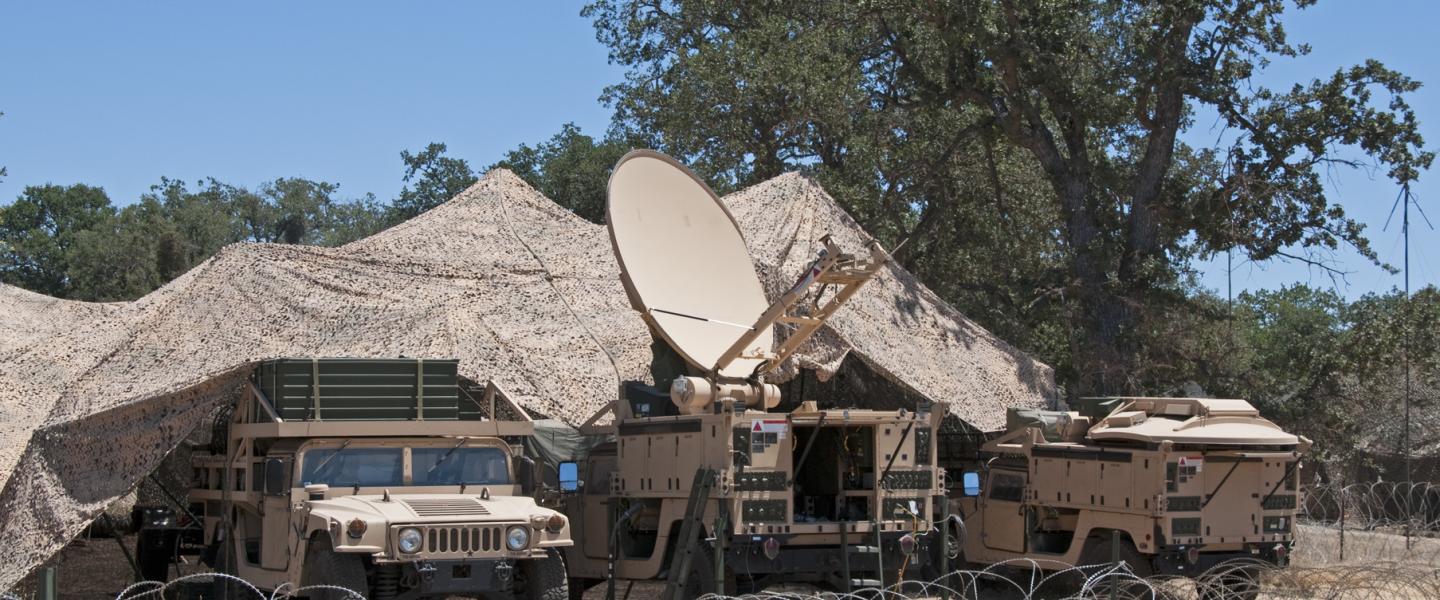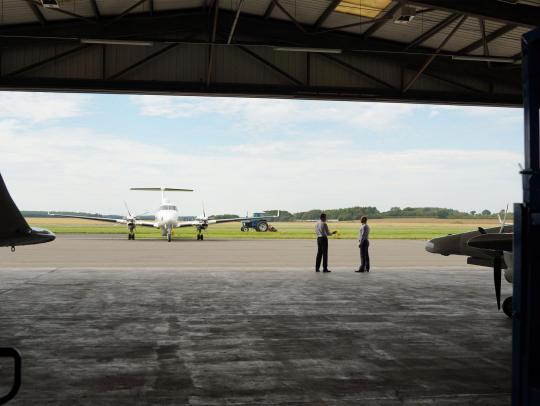Satellite – A Critical Infrastructure for Defence and Security

Speech by President and CEO of SES, Karim Michel Sabbagh at the Berlin Security Conference held on Tuesday, 17 November 2015
The omnipresent goal of our times is to connect everyone on this planet.
Notwithstanding, when we look at the number of geopolitical challenges we are facing, this goal becomes even more relevant in the area of adequate responses in our defence and security policies.
It is evident in the public discourse that connectivity is a key capability in our ability to cope with the societal and defence challenges we are facing.
Just consider two key indicators which impressively illustrate this dynamic:
Firstly, the commercial bandwidth used by US military has risen dramatically since the Desert Storm operation in 1990, from 100 Mbps used at the time by the military forces to 10-15 Gbps today. A 150x increase in just 15 years.
Secondly, take the bandwidth consumption of UAV platforms. While the Predator consumes 3 to 5 Mbps, the Reaper also rises to 5 to 10 Mbps, and the Global Hawk reaches an unprecedented level of 10 to 50 Mbps.
We are looking at a significant increase in bandwidth-intensive government centric applications.
Based on these unprecedented trends, how do we prepare to enter the next generation of defence and security connectivity?
We see three key elements that are crucial to fulfil our tasks: Assurance; Accessibility; and Acceleration.
Let me walk you through these points.
Assurance is the first element and it refers to the way we make sure communication networks are reliable and safe.
Located 36,000 km above the Earth’s surface and powered by sunlight, geostationary satellites are shielded from terrestrial disasters such as hurricanes and earthquakes, power disruptions, cable damage, civil disturbance or terrorist attacks.
Satellite solutions are territorially agnostic, flexible, rapidly deployable and constantly available even when terrestrial infrastructures are often overloaded, inoperable or disrupted by conflict.
Satellite connections transcend physical barriers and span geographic distances better than ground-based networks.
In fact, an encrypted point-to-point satellite link is much easier to protect than terrestrial links that can be intercepted almost anywhere on the terrestrial route.
Potential interferences can be detected instantaneously, thanks to geostationary location capabilities, and anti-jamming measures can be put in place immediately.
All these advantages are summarised in a figure that our engineers look at every day with pride. The technical availability of our space segment – i.e. our 53-satellite strong constellation – reaches the record level of 99.999992%.
This is unrivalled and clearly illustrates the extremely high performance level of our satellite communication.
The second element is Accessibility.
It is a fact today that a significant part of defence and security applications relies on satellite capacity.
And a large part of that capacity is coming from commercial satellite operations.
60% of the defence and security satellite capacity is coming from the military SATCOM sector (i.e. government-owned capacity) but the balance of 40% is coming from the commercial satellite sector.
The United States Department of Defence is the largest single customer of the commercial satellite sector worldwide, but other nations also make regular use of this capability.
It is clear that easy access to commercial space capacity is imperative to government agencies and institutions as they often require urgent and flexible bandwidth for their secure networks.
Just as electricity enables fundamental operations, satellite communications deliver capability across a countless suite of applications and for numerous mission requirements.
This invisible infrastructure is vital not only to the men and women of the armed forces, but also to civilian populations.
Commercial SATCOM is providing capacity that enables governments to improve the lives of their people and bridge the digital divide.
Satellite capacity is vital for disaster relief efforts and the delivery of e-education, e-health, e-governance and e-election networks.
Let me focus my remarks on the applications supported by commercial SATCOM most germane to the defence and security sector.
Intelligence, Surveillance and Reconnaissance (ISR)
One large driver of satellite demand is the requirement for ISR in its various forms.
Whether for purposes of border patrol, security in and around government facilities, or unmanned aerial surveillance missions – having a strategic awareness of areas of security exposure has become a priority to nations worldwide. What is not always known and appreciated is the role of satellite communications in delivering such a capability.
Border patrol
For the purpose of video screening and obtaining imagery in places where security personnel may not be present, commercial SATCOM can give governments persistent situational awareness of weaknesses or threats to the border.
UAVs
Or what some refer to as “Remotely Piloted Aircraft”: in fact, this area of Intelligence, Surveillance and Reconnaissance has become the fastest growth driver for government satellite communications requirements.
Maritime Communications
SES provides support on a global level for maritime operations to NATO nations and other international governments including the US.
Outside of traditional defence and security requirements, vessels leverage SES satellites in response to humanitarian assistance and disaster relief effort where other means of communications are not readily available or destroyed.
The recent earthquake in Nepal and the hurricane on the Philippines, where our emergency platform was successfully deployed, are just two examples.
This brings me to the third and last element: Acceleration.
Acceleration in a literal sense means: more and faster traffic.
Acceleration in the sense of innovation means: the creation of new concepts and technologies.
Let me start with the latter.
We have described so far a bold dynamic composed of a strong demand and an urgent need for commercial SATCOM complementing the military SATCOM sector.
But what is next? Our hypothesis calls for the creation of a third strong pillar, besides military- and commercial SATCOM. A new and innovative model called governmental SATCOM or GOVSATCOM.
GOVSATCOMCOM is about combining the strengths of a governmental engagement with the assets and knowledge of the commercial space. It combines an entrepreneurial logic and capital efficiency.
In this new GOVSATCOM segment, we will deliver high throughput with a high level of assured access.
The first cornerstone within this new model is LuxGovSat.
LuxGovSat is a new venture founded by SES and the Luxembourg Government.
Jointly held by SES and the Luxembourg Government, the objectives of LuxGovSat are the acquisition, the launch and the operation of a satellite for the provision of governmental and military communication services from 2017.
The Luxembourg-based company is funded in equal parts by SES and the Luxembourg Government, who each dedicated 50 million euros to the project. A loan of 125 million euros completes the funding.
The capacity of the new satellite will satisfy Luxembourg’s requirements for satellite communications in military frequencies. In fact, the Luxembourg Government has pre-committed to a significant amount of capacity as a tangible contribution to NATO.
Capacity would also be made available to governmental and institutional customers for defence and governmental applications.
The vital trait of LuxGovSat is the fact that it is a public private partnership.
This PPP combines the benefits of a politically and economically stable Government backing the venture, and the world leading satellite operator in providing reliable and secure SATCOM solutions.
This joint undertaking is based on full trust and transparency, as well as entrepreneurial and institutional expertise.
I submit to you that Public Private Partnerships will be the answer in meeting the defence and security needs of the future.
Armed with the industry know-how and backed up by the ambitions of countries to drive economic growth, PPPs will be instrumental in driving most significant technological innovations.
In addition, a PPP of that kind is well placed to avoid difficulties of measuring public tenders’ efficiencies through an in-built total transparency and thus can simultaneously make best use of tax payers’ and shareholders’ money.
As Mariana Mazzucato, professor for science and technology policy at the University of Sussex, pointed out:
The state, as risk-taker and driver of major infrastructure and innovation undertakings, deserves a fresh and better acknowledgement and a healthier role split with the private actors in order to not only subscribe to investments and risks but also to guarantee and frame the big picture and eventually benefit from successes.
Ladies and gentlemen,
I’d like to conclude with the second aspect of Acceleration that I mentioned.
It is about technical and data speed and efficiency.
We are investing in new infrastructures that are able to handle a multiple of data throughput that can significantly increase the fleet performance and flexibility, and allow us to infinitely scale our customer solutions.
Case in point are the O3b satellites – in which we have a significant investment – they orbit at 8,000 kilometres about Earth, and are ideal to serve high density and low latency networks.
The combination of high power beams offering more than 1 Gigabit per second is yielding an unprecedented value proposition to clients in industries covering maritime, energy, and telecommunications, but also to governments and their institutions.
Demonstrations jointly conducted this year by SES and O3b have elicited very positive feedback from government clients particularly in the areas of defence and security, with more to come in 2016.
What is important to note in this innovative model is the scalability of O3b as a future-proof system for next generation networks.
Ladies and gentlemen, with these two initiatives (LuxGovSat, O3b), we are demonstrating the strong fundamentals of our 53-satellite strong fleet in addition to O3b.
I am certain that it will also be a strong base for our governments, allies and institutional friends to build on with the objective to access future-proof solutions.
Thank you for your attention.




